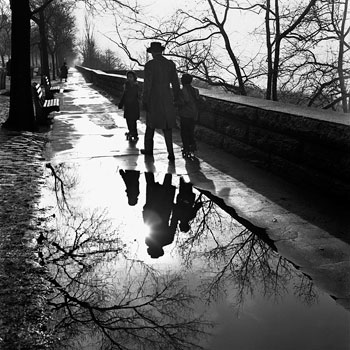
Opens December 20, 2011
What a story. Imagine finding 100,000 negatives, all by one unknown street photographer who worked from the 1950’s into the 90’s. They turn out to be amazing pictures; formally beautiful and really smart. Most are startlingly strong portraits of ordinary people. The photographer of this treasure trove turns out to have been a woman, a nanny who never had an art show, never apparently even showed her pictures to anyone, just kept taking them. There are a number of coincidences adding a “stranger than fiction” aura to this show. First, of course are the stunning street photographs by the unknown nanny, Vivian Maier and her tale of unrelenting artistic commitment. Add to this, the finder’s own back-story and chance discovery of the negatives, and the saga will undoubtedly resonate as much as the images.
The young Chicago realtor, John Maloof, who found boxes of Maier’s negatives at a storage facility auction, continues to research her past and shepherd her work’s introduction to the world. As he does this, details of Maier’s life emerge, but the untitled images so far scanned into a book and included in this exhibition are compelling enough to demand our attention without any subplot.
Maier’s photographs are powerful. Like Eugene Atget’s famous photographs from the turn of the 20th century that started street photography by documenting the streets of Paris, Maier’s pictures teem with the engrossing visual details of vibrant city street life and the bold, framing shapes of architecture. As beautiful as the patterns are made from fire escape shadows or tree limbs in a winter park, it’s the people in Maier’s pictures that are most remarkable. Perhaps because she was raised in France until she was 25, Maier clearly saw the broad sidewalks of cities like New York and Chicago as grand, democratic thoroughfares where all the different faces of American class and race could be seen. She aimed her lens at everyone; black and white, old and young, immigrants, working stiffs, fur draped matrons, merchants, commuters and street urchins.
Children in particular were a favorite subject. As in most of her portraits, Maier tells their stories succinctly by composing their bodies central to the image and letting the picture’s details uncoil into larger meaning. So we read something of neglect and perhaps self-reliance in the confronting gaze of a grubby-faced little girl wearing a really big watch. We are struck by the shy serenity of a tiny black boy leaning securely against the body of a white woman who is holding his hand before she crosses the street. The intense curiosity of childhood merges with art and observation in the flat nosed face of a child pressed eagerly up against a glass door that frames his small body like a painting in a gallery.
Some of Maier’s images bring to mind Diane Arbus’ photographs of the marginalized and deviant. But there is a keener sense of compassion and inquisitiveness to Maier’s selected subjects that never feels detached or voyeuristic. Her street people have feelings, and because they do, so do we. We feel the ache of the sagging old woman wearing one shoe and one slipper beside the open-air fruit stand. There is pride and fire in the blind glare of a vagrant with hair like a cock’s comb, eating a sandwich on a curb. The unforced humanity of Maier’s subjects is riveting. But so is her sense of humor that allows her to appreciate the self-defining snarl of privilege found in the disdaining gaze of the very fashionably dressed women who catch her taking their picture; as well as the unspoken family dynamics caught in the angular mimicking postures of two children impatiently waiting for their mother, who is having an interminable street corner conversation.
There is much in the way Maier use shape and contrast to outline her subjects against the densely fractured surface of the city or an open patch of flat sky that makes them feel emblematic of all humanity. In one image the dark shape of a father walking in a wet winter park with his two children is impregnated with hope by the unexpected reflection of the sun shining past their reflections in a puddle at their feet. In another, we see only the mountainous shape made by the dark rounded backs of two men sitting on a park fence rail as they look towards a bleak winter skyline. There is warmth and a silent reminder about friendship in their solidity and closeness that resonates in that cold space.
Like Henri Cartier-Bresson, whose work hers often suggests, Maier used her high contrast black and white photos to turn bodies into dense, solid forms of formal beauty. But always her subjects retain their humanity - usually with insight and flashes of dry humor. Bresson once said that, “In photography, the smallest thing can be a great subject. The little human detail can become a leitmotif.” It’s a statement that Maier’s work repeatedly affirms in the utterly unique moments she caught on film, and it underlines the compelling intelligence of her life’s work.
Published courtesy of ArtSceneCal ©2011
